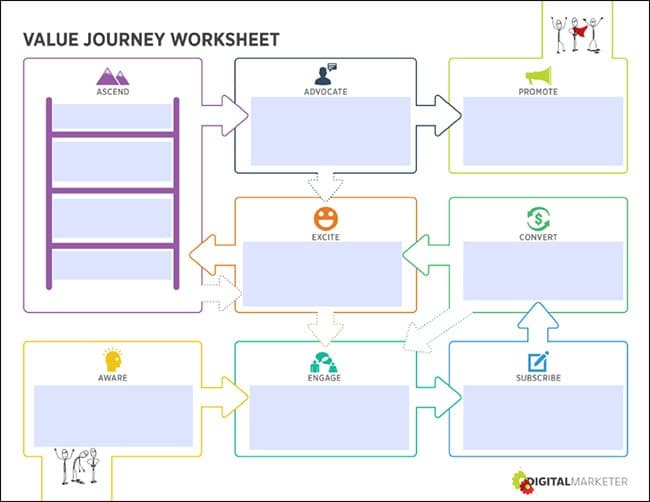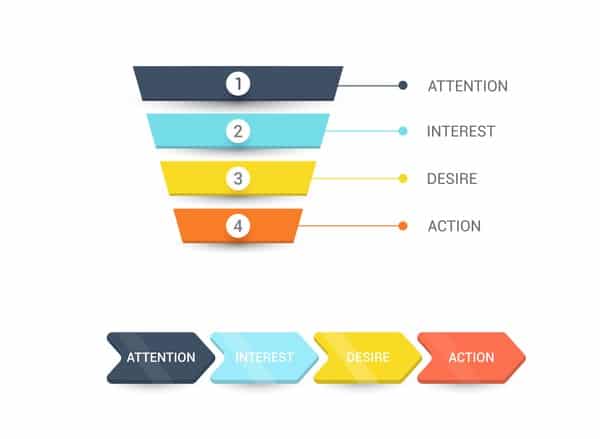Is your business in need of more sales? clicks? engagement?
How about you just want to improve your digital marketing, you need to understand the Customer Value Journey (CVJ) and how to implement this into a sales funnel.
The Customer Value Journey is about turning strangers into super-fans.
All businesses need a “sales funnel” no matter how long they have been in business.
Sales funnels are important because it takes your customers on the journey of the buying process.
Proper sales funnels will turn website visitors into subscribers, and subscribers into customers or clients.
The CVJ stands out among the crowd because it gives you a simple step-by-step process for attracting, converting, and keeping your best customers.
We want to give you a head start on implementing this strategy into your own business.
Setting out the Customer Journey
The Customer Value Journey is an 8-step path that people travel as they discover your brand, build a relationship with you, and become buyers and raving fans.
No one finishes this Journey alone. Left to themselves, customers will get lost or even forget about your business along the way.
That’s why you need to create a strategy and sales funnel that walks people through all 8 steps, giving them a boost when they get stuck and encouraging them every step of the way.

Sales Funnels: What They Are & Why Your Business Needs Them Now
A sales funnel isn’t as intimidating as it sounds. Essentially, it’s the customers online journey which they go through to become customers. The word “funnel” is used, because of the shape of the funnel mimics the amount of people that go throughout the sales funnel process.
Here’s a graphic to describe a sales funnel:

The Steps Of A Sales Funnel
There are several phases of a sales funnel as you move further and further down the funnel.
This is where we use automated system to help guide the customer to take the next step.
Below is a quick description of each phase.
Becoming Awareness: Potential customers start to become aware of your business.
This can happen through advertising, blog posts, events, word-of-mouth, social media, or any other channel that puts your products, offers, and solutions in front of your ideal prospects.
Engage With Your Brand: This is all about creating a relationship with your audience. The dictionary defines engagement as emotional involvement or commitment. It’s about being in gear with someone, building or deepening a relationship with them.
Through the entire sales funnel you want to make sure that your potential customer is engaging with your brand, reading the content you provide, watching the videos you make to help them increase there knowledge and understanding of your product or service.
Subscribing To Your Database: When someone likes their experience and the value you bring to them, they will start to trust your brand. When that happens, it’s time to ask for a small commitment—subscribing and giving you permission to add them to your database so you can nurture them.
Today, people are careful about giving out their email address. You have to offer something valuable that makes it worth their while. Think webinars, reports, guides and free samples of a product or chapters of a book,
You offer something they want, they fill out a form to get it. It’s that simple.
Make Them a Customer: If the subscribers you gain in Step 3 of the Journey remain engaged, some of them will be ready to increase their level of commitment. A prospect shows that commitment by investing time or money.
This is a critical stage in the sales funnel.
The key to success in this stage is to employ what we call “entry-point offers”. These offers are designed to give the new prospect tremendous value without forcing them to put too much “skin in the game.”
This is not the time to ask your prospect to invest a significant amount of money on a complex product or service.
Now, you only need to ask for small commitment: say, £5–£20. Aim to cover your costs in acquiring the customer.
Get Them Excited About Your Brand: At this point your new customer has had a transaction with you. A small transaction, but a transaction nonetheless.
Now it’s essential to make sure that transaction is a good one.
The reason why is simple: if the person doesn’t get value from this transaction, they won’t move on to the next stage and purchase more expensive things from you.
Make Them a Customer: At this stage, your goal is to generate repeat buys and real profits. While your entry-point offer was designed for conversions and to cover the cost of acquiring the customer, your ascension offers should be geared for profits—because if you’re serving your customers well, they’ll will continue to buy from you again, you can also offer them simple upsells made after that initial purchase…
Why Your Business Needs a Funnel.
Every business needs a sales funnel to survive in a competitive marketplace.
Anyone who is selling a product or a service needs a proper sales funnel strategy.
Without mapping out your customer value journey, your marketing efforts may not get you aware because your potential customers are unclear as to what the next steps are in the purchasing process.
You want to nurture your potential leads to the point where they realise they can’t live without buying your product or service.
Great thing about sales funnel is that they can operate 24/7 turning ice cold prospects into buyers.
This will help increase your leads, sales and profit.